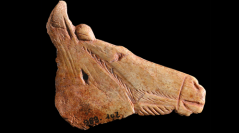

 Anthropozoologica
55 (16) - Pages 233-246
Anthropozoologica
55 (16) - Pages 233-246The category of animal species is classically used by archaeology to study the relationships between humans and animals in the Paleolithic, both in the analysis of animal bone remains and in the analysis of animal figurations. However, an examination of the remains from the Middle Magdalenian period offers additional perspectives to such a classification. An important realism can be observed in the depiction of animals. In parietal art, in the ornamentation of tools, and in the production of body adornment objects, while some details are limited with the identification of animal species, other details provide great precision, often showing animal individuals whose age, sex, attitude or particular morphology can be recognized. In addition, the butchery practices of the Middle Magdalenian show a very meticulous disarticulation of the hunted animals, which could indicate a ritualization characteristic of respect for the animal being handled. An over-representation of skulls of animals and humans can be observed in the sites of the Middle Magdalenian, and suggests an attraction of populations for this type of skeletal element. The head, emblematic of individual identity, is also the subject of a particular investment in figuration, leading to the probable production of portraits of humans and animals. Finally, many pragmatic techniques for linking human and animal individuals seem to confirm the importance of the category of individuals. Thus, although the notion of animal species is an undeniably important classification medium for the Middle Magdalenian, the way animals are approached in this context sometimes seems to follow the path of individualization.
Individuals, animals, Paleolithic, Middle Magdalenian, depiction, zooarchaeology.